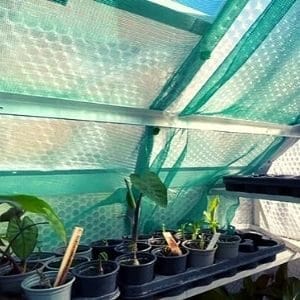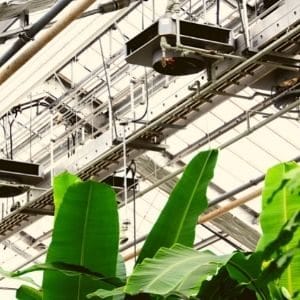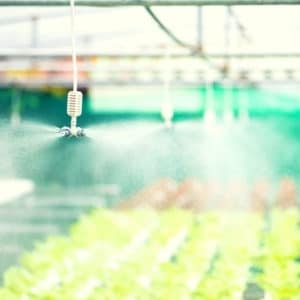A greenhouse can be defined as a loyal friend of a gardener. So in retune, he must be able to control a certain number of parameters. Temperature is one of them. Too high in the summer can slow down the development of plants grown indoors or even endanger them.
There are several steps you can take to keep the greenhouse cool. Shading, cooling, and ventilation are some of them that prevent the greenhouses from overheating, creating a stressful environment for plants.
So, if you are wondering how do you keep a greenhouse cool in summer, read on. We are going to discuss 5 effective tips on this matter.
Importance of Cooling: What Effect Do High Temperatures Have On Plants?
It is possible to obtain excellent yields in a warm climate but be prepared for its possible disadvantages. Here are some problems that can arise with high temperatures:
- Plants can withstand ambient temperatures of up to 40 ° C as long as they have an adequate amount of water. It helps to continue perspiring. If the temperature rises above 45 ° C, the plants will likely die. Or a part of their tissue will wilt, especially if they are very young or recently transplanted plants.
- Other problems can occur in our plants. For example, pollen viability can decrease significantly in tomato crops when temperatures are above optimal. This can result in poor fruiting or fruit abortions. The same can happen in other fruit-forming crops, such as chili peppers, peppers, and cucurbits.
- Excessive solar radiation is another risk factor, as it can cause the so-called “sun blow.” It damages the quality of the fruits and generates significant losses when rejected by the market.
- Temperatures above 38 ° C have effects on the skin of fruits such as cucumbers and peppers. They cause tissue death (necrosis) or yellowish or brown spots.
- Finally, some diseases proliferate with excessively hot temperatures. For example, the bacterial spot in tomato and chili peppers; bacterial wilt in tomato, and the fungus.
Now that you know how dangerous high temperatures can be, you should concentrate on cooling the temperature in the greenhouse.
We tell you how.
How Do You Keep a Greenhouse Cool in Summer?
Tip 1: Proper Ventilation
From a practical perspective, the first step in cooling the greenhouse is to ventilate it. In other words, exchange the captured heat with fresh air from outside.
The ventilation system in a greenhouse will replace the warmer air that is inside with another cooler air mass that comes from the outside.
In this way, a large part of the heat overload can be evacuated. This will reduce the temperature and, in turn, modifying the concentration of gases and humidity.
Two ventilation systems can be adopted: mechanical ventilation and natural ventilation.
Natural Ventilation:
In natural ventilation, the hot air inside the greenhouse rises and goes outside through two openings located on the roof. At the same time, the intake is made from two openings in the lower part of the side facades.
In this way, an airflow is created that covers the entire interior space. For this type of ventilation, large openings are necessary, between 15% and 25% of the roof surface. It does not allow controlling the incidence of air velocity on the plants.
Mechanical Ventilation:
Simple mechanical ventilation is based on the renewal of the air by installing fans or electromechanical elements in the roof. The air inlets coming from the outside are located in the lower part of the opposite wall.
The wet mechanical ventilation system is based on saturating the inlet air with humidity. In this system, air passes through large panels made of a fibrous material soaked in water.
If the greenhouse is very wide, the layout of ceiling fans and air inlets with wet panels should be adopted on both sides of the building.
Tip 2: Shading

The most common is to use shading. Shading helps to reduce the amount of solar radiation reaching the greenhouse and the plants themselves.
Typically, the goal is to lower the leaf temperature rather than reach a specific light intensity.
Of course, there are some plants that prefer to be under shade or under a canopy. And they do not support too intense light, accompanied by the resulting heat.
Another important point is that it is much more efficient in keeping excess radiation out of the greenhouse before radiation enters.
Depending on priorities related to climate and greenhouse economics, dual-purpose energy shade curtains are used. This is less expensive because the greenhouse structure protects it.
When selecting a shading method, the ideal strategy is to use a retractable system. In this way, shading can be done when it is too hot. You can also stop shading when temperatures are not a problem/when available light is a limiting factor for growth.
You can use a fixed system of shading, shading paint, or chalk. But in this system, you will be reducing the available light 24 hours a day.
If the amount of light is always excessive, this practice is not a problem. Although in any case, this system is not ideal. There may be certain hours when the temperature is not a limiting factor.
When selecting the material, it is much better to select reflective materials than to choose materials that absorb light.
Tip 3: Water Spraying and Nebulization
It consists of distributing water sprays throughout the room that diffuse drops throughout the environment.
These drops of water evaporate, absorbing a large part of the solar energy received. Thereby they cool the environment.
As this system does not have ventilation, it is inferior to humid ventilation. So it is advisable to combine it with simple ventilation.
One drawback to note is that spray equipment is very delicate. It happens due to the ease of clogging the small holes in the jets with the salts of the water.
Tip 4: Water Tank
The water tank that lies to the north helps keep the dome cool and moist. This natural cooling is all the more effective when the reservoir contains a large amount of water.
The medium-sized dome holds four thousand liters of water. It can become a water garden, and you can grow aquatic plants or breed fish. This reservoir creates a wonderful pool.
Tip 5: Whitewash/Liming
One solution is to whiten the walls. It is based on the whitening of greenhouse walls and covers based on carbonate, calcium, or lime.
This is one of the cheapest ways to cool the inside temperature.
Although this is one kind of shading, it is more affordable, easy to use, and breathable.
Mix the lime with water or dishwashing soap (for better adhesion) and spray it on the walls. Remember to use it on glass walls as it can deteriorate the plastic wall.
Conclusion
So, how do you keep a greenhouse cool in summer? In many ways.
But we mentioned some of the ideas which are either the most effective or most affordable. They are easy to adopt and have been used for decades by gardeners.
Also, these temperature cooling methods have proven to be an essential part of the Dome Greenhouses’ design. They help create optimal conditions for the growth of vegetables and flowers. Hopefully, they will help you too.
Happy gardening.



